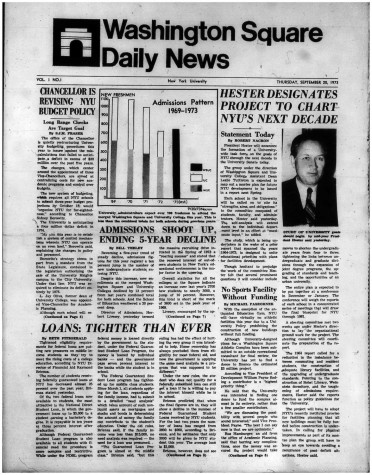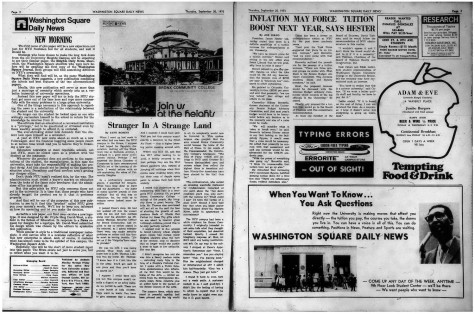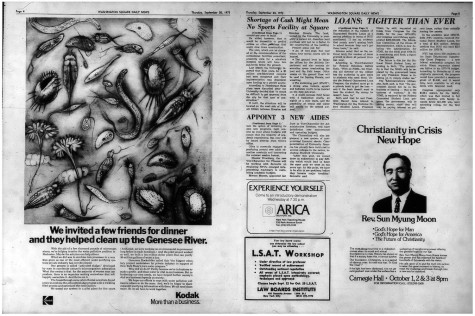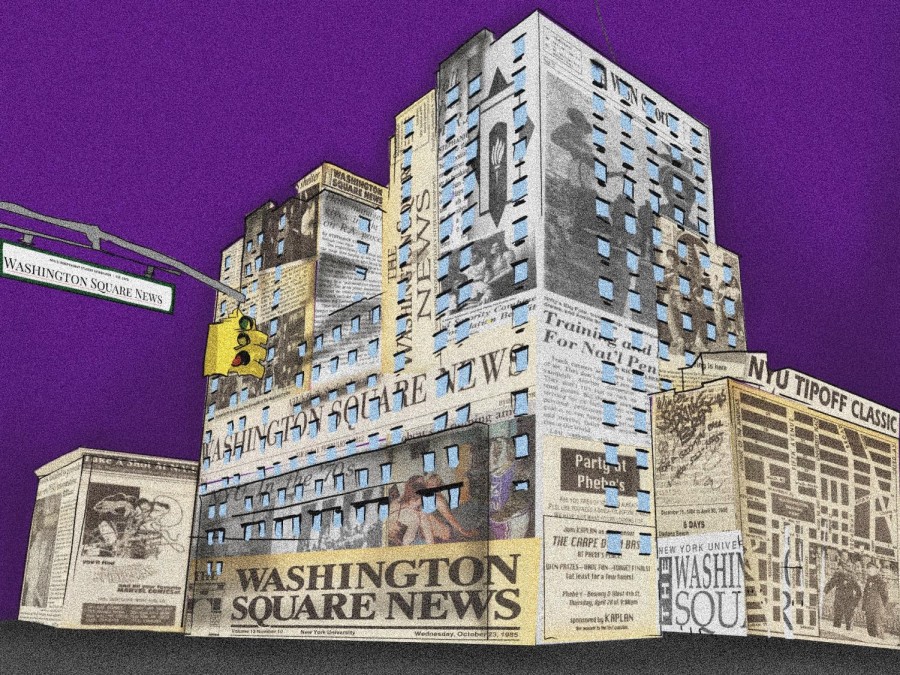If you walk into the basement of NYU’s Third Avenue North residence hall on a Sunday morning, you’ll be greeted by what may seem like utter chaos: furious typing at every desk, a cow bell ringing to signal conference room meetings and the murmuring of editors trying to perfect their stories for the day. This organized chaos makes up Washington Square News, but there’s a lot behind this day-to-day commotion.
WSN was founded in 1973, the year when NYU sold its University Heights campus in the Bronx and merged with the Washington Square campus most students know today. The student newspapers of each campus — “The Heights Daily News” and the “Washington Square Journal” — combined to make the university’s first daily paper, which still publishes today. Originally called “Washington Square Daily News,” WSN dropped the “Daily” from its name before 1976.
This year, NYU’s paper celebrates its 50-year anniversary.
New beginnings

Volume one, edition one of WSN printed on Thursday, Sept. 20, 1973. The paper promised to hold the university accountable not only for its impact on incoming students, but also for those already paying tuition. An article introducing the paper titled “New Morning” headed the edition’s second page.

“One of the things necessary in this approach to reporting the news is a redefinition of the relationship between the student and the university,” the article reads. “No longer can the student be looked upon as one who willingly surrenders himself to the school in return for the knowledge he receives from it.”

Since then, WSN’s stories have done exactly that, with many themes from its 2023 articles mirroring those featured in its 1973 edition. Headlines from the first paper include “Loans: Tighter than ever” and “Inflation may force tuition boost next year,” issues students still face — and cover in the news — at NYU today. The 1973 paper tackled construction lawsuits at Bobst Library and faculty unionization struggles, similar to recent coverage of the construction and opening of the new Paulson Center and the adjunct faculty’s struggle to secure a contract with the university. Fifty years ago, the paper covered protests in Washington Square Park calling for former president Richard Nixon’s impeachment. Today, it covers transgender rights and anti-Immigration and Customs Enforcement protests in the very same park.
“The students are essentially customers at a university,” said Alvin Chang, who served as WSN’s editor-in-chief in 2007 and the editorial staff’s adviser during the 2021-22 academic year. “There’s just not that many places where the student’s voice can carry weight and students’ concerns can carry weight, and an independent student newspaper plays a pretty integral part of that,” he said.
Breaking stories
Over the course of its time at NYU, WSN has published countless stories that have led to tangible changes on campus and beyond.
An iconic example of this was the paper’s 2004 coverage of “Bobst Boy,” a student who lived in Bobst Library for nearly eight months. WSN reported that then-sophomore Steve Stanzak had been living in Bobst, showering at friends’ apartments and nearby gyms. On his personal blog and in an interview with WSN, Stanzak attributed his multi-month stay in the library to the high cost of housing and limited financial aid at the university.
“One of the reasons it gained a lot of traction was because it was such a quintessential NYU story — one that really captured essentially the struggles of being in New York City, at NYU, and not having a real campus,” Chang said of the coverage, which was published just before his time at the paper.
After the story broke, larger publications such as The New York Times and the BBC quickly wrote about it too. NYU eventually provided Stanzak with free on-campus housing in Lafayette Hall for the rest of the semester.
In November 2008, then-editor-in-chief Adam Playford and reporter Marc Beja investigated crime statistics at NYU. In a multi-part investigation, they found that the university underreported substance abuse incidents on campus. They reported that NYU utilized a campus map that only included three residence halls, and claimed the others were considered to be off campus. The university was thereby able to boast a comparatively small number of on-campus crimes.
“They had said there were like two instances of any drugs on campus in years and years,” Beja said. “I spoke to some experts and they were like, ‘NYU’s totally fudging this.’”
In 2008, the series won a national award for in-depth reporting from the Society of Professional Journalists, one of the nation’s most well-known journalism organizations.
“I recall the university being kind of receptive, and when we sat down with the vice president of public safety, they were like, ‘Oh, gee, is that really how we do that? We hadn’t thought of that before,’” Playford said.
Russell Berman, who was WSN’s editor-in-chief in the fall of 2003, and is now the paper’s editorial advisor, helped edit coverage of a string of suicides, that took place at NYU, some inside Bobst Library, between 2003 and 2005. As a result, the university installed aluminum guardrails, which still exist, on each floor as a preventative measure. This addition and its history was revisited in a 2022 feature piece.
“It was a very difficult news story to cover, because it’s such a tragedy when somebody takes their own life and in such a way,” Berman said. “But it taught me a lot about how to cover those stories in a way that’s both responsible and sensitive.”
Entering a digital world
In 2000, WSN launched its website. The newspaper maintained both a print and online edition for 20 years, but it went fully digital after the pandemic.
This shift was not as simple as it sounds, though. As Chang explained, what ensued was a complete re-prioritization of how daily production took place.
“The timing of having to get a certain number of stories published and ready every single day drove a lot of the WSN workflow,” Chang said. “We didn’t focus enough on the shift to digital because a lot of times we would get to the end of the night and send off the paper and then a handful of us would as fast as possible try to post the stories online.”
The first version of the website was a simple black-and-white interface. It listed several stories and had a small menu on the side, linking to the paper’s different sections. Over the next few years, the website introduced color, images and advertisements, expanding to include online-only stories and longer features.
As the website grew, the print edition of the paper quickly lost readers’ interest. According to Chang, advertisers started to prefer digital ads over print ones, and students picked up physical editions of the paper less frequently.
Beja recalled the newsroom’s reaction when WSN stopped publishing its Friday print edition, in 2008.
“I wrote the story when we dropped the Friday edition — people were mad about it internally and I was like, ‘no, guys, we have to write this,’” he said. “We’ve been a daily print paper for years … People were really upset.”
During the pandemic, the paper’s daily production was forced to go fully virtual. When writers returned to WSN in 2021, Chang pushed to drop the print edition altogether, and the main focus became the website.
Sasha Cohen, the paper’s arts editor during the 2020-21 academic year, remembered experimenting with the digital design of the paper’s arts issue when the paper’s staff was moved online.
“How could we reinvent the way in which we’re presenting content?” she asked. “Something we were really fascinated by was mixed media, finding this intertwining between digital images and illustration.”
Today, WSN’s website looks vastly different. Its red-and-black color scheme is apparent across the page, and vibrant images accompany every story. Users can navigate hundreds of pages, sections and subsections, all with just a few clicks.
The walkout and the return
Running a daily campus newspaper isn’t always the easiest task, and the newspaper faced one of its biggest obstacles in the fall of 2020. Cole Stallone, the editor-in-chief at the time, was fired without warning, and a new advisor, Kenna Griffin, was brought in without full disclosure of her powers and responsibilities over the staff.
Quickly, issues arose with Griffin’s behavior toward staff members, as well as the level of independence WSN had from the university.
Disagreements with the advisor reached a breaking point on Sept. 28, 2020, when nearly the entire editorial staff resigned. For roughly a whole semester, NYU didn’t have its student paper.
“People’s individual feelings on staff, they were hurt and they were offended by certain words and actions,” said Manasa Gudavalli, who was a deputy multimedia editor at the time of the walkout, and will be editor-in-chief during the next academic year. “All of a sudden, a New York Times article came out about it, and it really hit me how serious this was. Every college has a student paper. We are NYU’s main source of news and information.”
The future of WSN remained uncertain for months, until a group of alumni came together to rebuild the paper. They reached out to the previous staff and brought some back to the newsroom.
The editorial board, which consisted of NYU journalism professors and senior staff members at WSN, expanded to include additional staffers, allowing for more student representation. The alumni also focused on promoting diversity in the newsroom and working to rekindle relationships with student activist groups that had previously boycotted the paper due to its portrayal of them.
“To be able to come back with old and new faces after a time when so much has changed both on a [COVID-19] standpoint and an organizational standpoint really just provided an opportunity to reassess what exactly we wanted to do with the paper and what kind of work we wanted to showcase,” Cohen said.
“WSN meant a lot to people, and it was really valuable to a lot of people both in terms of their personal lives, but also their professional lives,” said Chang, who was part of the alumni group that reinstated the paper. “You just kind of take it for granted, you expect it to be there, and for a university like NYU with a huge journalism school to be able to support a student newspaper. But it doesn’t exist unless people actually support the institution.”
Despite its obstacles, WSN has remained a space of collaboration for writers and contributors to work together, and ultimately put out a daily paper while gaining valuable skills for future jobs — in journalism or otherwise. It’s also remained a way to make friends that last far beyond the newsroom.
“Almost all of the friends that I still keep in touch with from my days at NYU, nearly 20 years later, are people that I met and became friends with while working at WSN,” Berman said.
“A lot of these people are people that I know 20 years down the line, I will still be in touch with,” Gudavalli said. “And I think that’s a really sweet thought.”



























































































































































